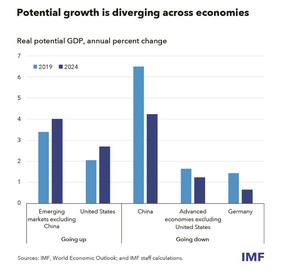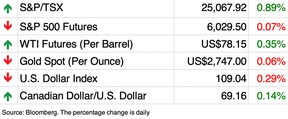Canadian mining and manufacturing in the firing line, say Desjardins
Article content

Article content
Article content
Canadian companies are bracing for a tariff tsunami when Donald Trump takes office today, but according to a new report, some should be more worried than others.
Trump, whose team has reportedly prepared more than 100 executive orders ready for signing after his inauguration, has said he would impose 25 per cent tariffs on all imports from Canada and Mexico. For our nation, where 70 per cent of exports go to the United States, this is a big threat.
Advertisement 2
Article content
To get a handle on it, principal economist Florence Jean-Jacobs and her team at Desjardins Group analyzed the potential impact of tariffs on individual sectors.
“While it looks like Canadian exports ended 2024 on a strong note as the prospect of tariffs encouraged U.S. companies to build up their inventories, this trend could reverse course in 2025 after Donald Trump takes office,” she wrote.
How vulnerable a sector is boils down to how dependent America is on the particular product and whether it can buy it somewhere else.
About half the value of Canada’s output in mining and oil and gas is exported to the U.S. and about a third of manufacturing, though the percentage is higher in the auto sector at about 50 per cent and in aerospace at 40 per cent.
Oil and gas and the auto industry have attracted the most attention amid trade concerns and are most dependent on the U.S. for exports, but they are also most likely to be exempted, said Desjardins.
America doesn’t produce enough crude oil to meet its needs and gets 58 per cent of its imported oil from Canada. Slapping tariffs on this product would risk raising prices which goes against Trump’s promise to bring fuel costs down.
Article content
Advertisement 3
Article content
The auto industry is highly integrated, meaning that exporter and importer are often the same parent company. Half of the General Motors Co. pickup trucks sold in the U.S., for example, are imported from Canada and Mexico, said the report. If their costs go up, these multinational giants are likely to lobby for exemptions.
The primary metals sector, food and beverage manufacturing, chemicals, machinery and aerospace, however, are not so lucky and Desjardins considers them most vulnerable to tariff pain.
Canada exports about 41 per cent of its primary metal production to the U.S. and Quebec exports 54 per cent, representing in dollars about $44 billion and $16 billion, respectively, said the report. Though American does not produce enough of these products to meet its needs, it can get them through other foreign suppliers. Desjardins calculates that if tariffs reduce demand in this sector by 10 per cent, industry revenues would slump 4.1 per cent in Canada and 5.4 per cent in Quebec.
Other sectors are vulnerable because America already makes enough of their products on its own. This is true for lumber, transportation equipment other than autos, paper and cardboard, agricultural food and petroleum-based products.
Advertisement 4
Article content
Then there are the products the U.S. can easily get from another supplier — pharmaceuticals, basic chemicals, machinery and processed petroleum products. The petroleum and coal products America now gets from Canada could easily be sourced from South Korea, India and Netherlands and pharmaceuticals could come from Ireland, Germany and Singapore.
There are some Canadian products, though, America would find hard to do without. Desjardins believes uranium ore will likely to be exempted from tariffs because the U.S. imports almost all of its supply — 27 per cent from Canada, 25 per cent from Kazakhstan and 12 per cent from Russia.
Potash, used extensively on American farms in fertilizer, is not mined in the United States and with Canada being the world’s largest producer, there are few other options.
Cobalt and graphite, critical minerals used in batteries and electronics, are also likely to be exempt as the United States has invested in Canadian production to reduce its dependence on Chinese suppliers.
However, the impact on sectors vulnerable to tariffs won’t stop there. Transportation and warehousing, wholesale trade and professional services would suffer from spill-over effects and even industries less exposed to trade will feel the pinch of the economic slowdown tariffs bring on, said Desjardins.
Advertisement 5
Article content
“Clearly, businesses need to plan ahead as they navigate today’s shifting trade winds and find strategies to mitigate their risks, like boosting interprovincial trade, diversifying exports away from the U.S. and investing in innovation and modernization,” wrote Jean-Jacobs.
It’s times like these when a weak Canadian dollar comes in handy. A lower loonie means Canadian products will cost less in U.S. dollars, partially offsetting the hit from tariffs, she said.
Sign up here to get Posthaste delivered straight to your inbox.


Take heart Canada, our economy might be lagging the United States, but we’re not alone.
The divergence between the U.S. and other economies was the talking point of the International Monetary Fund’s global growth forecast Friday. Though the IMF’s outlook was broadly the same as in October, divergences across countries are widening. Basically, the U.S. has rebounded back to its pre-pandemic growth potential, while other advanced nations and China have not.

- U.S. president-elect Donald Trump will be sworn into office on Monday. He has threatened to impose 25 per cent tariffs on goods headed to the U.S. from Canada and Mexico on his first day as president unless the two countries stop illegal border crossings and prevent illicit drugs from entering the United States.
- U.S. markets closed for Martin Luther King Jr. Day
- The Bank of Canada releases its business outlook survey and its Canadian survey of consumer expectations
Advertisement 6
Article content




With all the uncertainty around the capital gains tax hike, tax expert Jamie Golombek takes a deeper dive into who may be affected, and the monetary trade-off of choosing not to follow the Canada Revenue Agency’s guidance. Find out more
Calling Canadian families with younger kids or teens: Whether it’s budgeting, spending, investing, paying off debt, or just paying the bills, does your family have any financial resolutions for the coming year? Let us know at wealth@postmedia.com.
McLister on mortgages
Want to learn more about mortgages? Mortgage strategist Robert McLister’s Financial Post column can help navigate the complex sector, from the latest trends to financing opportunities you won’t want to miss. Plus check his mortgage rate page for Canada’s lowest national mortgage rates, updated daily.
Financial Post on YouTube
Visit the Financial Post’s YouTube channel for interviews with Canada’s leading experts in business, economics, housing, the energy sector and more.
Today’s Posthaste was written by Pamela Heaven, with additional reporting from Financial Post staff, The Canadian Press and Bloomberg.
Have a story idea, pitch, embargoed report, or a suggestion for this newsletter? Email us at posthaste@postmedia.com.
Recommended from Editorial
-

Canada’s own trade barriers amount to nearly 25% tariff
-

The ‘old normal’ is back and that means higher interest rates
Bookmark our website and support our journalism: Don’t miss the business news you need to know — add financialpost.com to your bookmarks and sign up for our newsletters here
Article content
Who Donald Trump’s tariffs would hurt the most
2025-01-20 13:57:04






